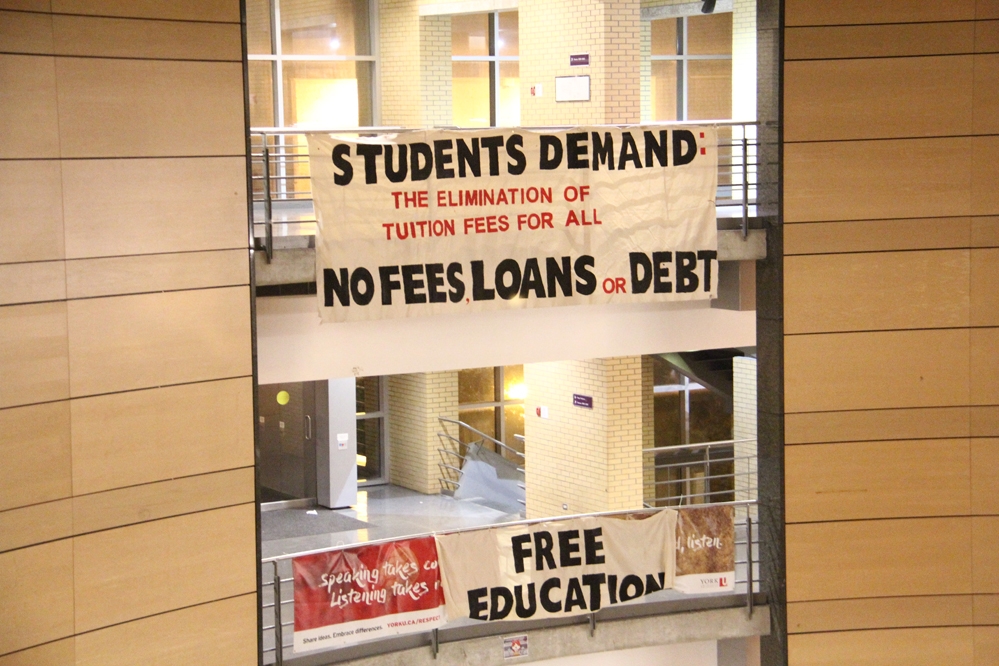Kanchi Uttamchandani | Assistant News Editor
Featured image: Participants in the Fight the Fees day of action, which included the YFS and supporting student groups, marched on Queen’s Park demanding free tuition. | Amir Yazdanparast
On its national day of action, the Canadian Federation of Students, or CFS, and its allies marched on Queen’s Park to demand free tuition. The CFS is demanding the Ontario government eliminate tuition fees, convert the provincial part of student loans to non-repayable grants and get rid of outstanding interest on existing student loans.
“Free tuition means an education that is not only free of financial barriers, but includes universal access to education, education justice and public education for the public good,” says CFS National Executive Representative Gayle McFadden.
The campaign received overwhelming public support with over 40,000 signatures delivered to Queen’s Park.
However, the Fight the Fees campaign and its demands have not been immune to criticism.
One student distinguished between accessible and free tuition.
“I think the CFS’s goal of having accessible tuition is a modest one. It is something I praise and I laud. But the goal of having free tuition is different in essence from having accessible tuition,” says fourth-year political science student Hezekiah Davies.
“You can’t fight for accessible and cheaper [education] and then fight for free [education] on the same day. It doesn’t coalesce,” he adds.
Davies says free tuition would diminish the value of a university education and saturate the job market.
McFadden states the Ontario Student Grant is a direct result of CFS’ demands to create a more useful needs-based grant out of former grant money, but it’s unclear whether the student movement can claim victory entirely for itself because the government spearheaded the initiative.
Jonah Hart, co-president of Campus Conservatives York University, points out that when new government policy initiatives are created, MPs acknowledge their colleagues who sponsored the bill, as well as the organizations and individuals that crafted the legislation or fought for it in the chamber.
Hart highlights that Ontario pays almost $12 billion annually in debt interest, which is more than the province spends on colleges and universities.
“This system is broken, and throwing more money at it is not going to help anyone, especially considering the province is debt-ridden,” says Hart. “If students want a change, they should vote for parties that commit to driving down the debt before anything else.”
Schulich professor Fred Lazar thinks that while there are several problems with the contemporary education system, free tuition cannot be advocated as a catch-all solution.
“Direct subsidies is the solution, not a blanket zero-tuition policy, which will assist many students who do not need financial assistance,” he says.
“Why is free tuition more important than expanding health care, or investing in infrastructure?” questions Lazar.
“There are trade-offs and with the exception of low-income families, this is an area that extends beyond access to universities. Free tuition does not have as high a priority as others.”
“It’s about priorities, and the government needs to prioritize free and accessible education for all. We should challenge decades of ‘fend for yourself’ thinking in public post-secondary education policy,” says McFadden.
YFS VP Campaigns and Advocacy Rawan Habib stressed that the campaign was not over after the day of action, saying many don’t understand how post-secondary institutions work and get funded.
“Education is a right, not a privilege, and everyone deserves equal access to education. Your access to education should not be dependent on your income bracket. Education in itself is valuable, and in it’s privatization, we are losing that value and quality,” says Habib, adding that it’s important for the conversations that inform and agitate students to continue.
“Whether this looks like continuing regular Education Coalition meetings, hosting town halls, or organizing other actions to continue pressuring our administration and our provincial government, there are many different avenues in which we are looking forward to keeping the momentum going,” she maintains.
Economics professor George Fallis highlights the difference between education as a ‘human right’ as opposed to ‘highly desirable.’
“The UN Universal Declaration of Human Rights does not state that higher education should be free. It states that ‘everyone has the right to education’ and that ‘Education shall be free, at least in the elementary and fundamental stages,” asserts Fallis.
With a university education widely considered to be a basic job requirement and a pathway to higher income, there is a clear argument for making higher education more attainable for students.
“Education has never been free—someone has always had to pay for it. The question has only ever been ‘who?’ The benefits to us all of everyone having at least a secondary-level education mean we willingly pay taxes to ensure that every Canadian child can attend high school,” says economics and public policy professor Brenda Spotton Visano.
“Someone paid for us to attend high school, so all we are really doing is paying that consideration forward. We benefitted from an accessible high school education earlier in life and are, through our taxes, ensuring that the next generation has the same advantage.”



That takes us up to the next level. Great potinsg.